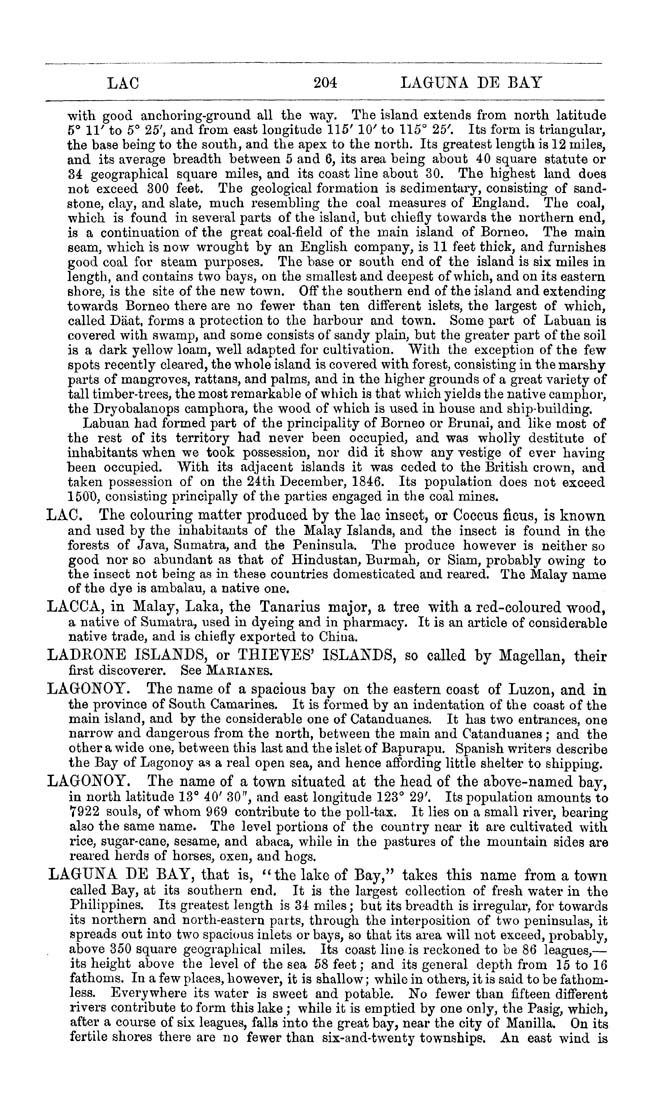LAC 204 LAOUNA DE BAY
with good anchoring-ground all the way. The island extends from north latitude
5** 11' to 5° 25', and from east longitude 115' 10' to 115° 25'. Its form is triangular,
the base being to the south, and the apex to the north. Its greatest length is 12 miles,
and its average breadth between 5 and 6, its area being about 40 square statute or
34 geographical square miles, and its coast line about 30. The highest land does
not exceed 300 feet. The geological formation is sedimentary, consisting of sand¬
stone, clay, and slate, much resembling the coal measures of England. The coal,
which is found in several parts of the island, but chiefly towards the northern end,
is a continuation of the great coal-field of the main island of Borneo. The main
seam, which is now wrought by an English company, is 11 feet thick, and furnishes
good coal for steam purposes. The base or south end of the island is six miles in
length, and contains two bays, on the smallest and deepest of which, and on its eastern
shore, is the site of the new town. Off the southern end of the island and extending
towards Borneo there are no fewer than ten difi'erent islets, the largest of which,
called Daat, forms a protection to the harbour and town. Some part of Labuan is
covered with swamp, and some consists of sandy plain, but the greater part of the soil
is a dark yellow loam, well adapted for cultivation. With the exception of the few
spots recently cleared, the whole island is covered with forest, consisting in the marshy
parts of mangroves, rattans, and palms, and in the higher grounds of a great variety of
tall timber-trees, the most remarkable of which is that which yields the native camphor,
the Dryobalanops camphora, the wood of which is used in house and ship-building.
Labuan had formed part of the principality of Borneo or Brunai, and like most of
the rest of its territory had never been occupied, and was wholly destitute of
inhabitants when we took possession, nor did it show any vestige of ever having
been occupied. With its adjacent islands it was ceded to the British crown, and
taken possession of on the 24th December, 1846. Its population does not exceed
1501), consisting principally of the parties engaged in the coal mines.
LAC. The colouring matter produced by the lac insect, or Coccus ficus, is known
and used by the inhabitants of the Malay Islands, and the insect is found in the
forests of Java, Sumatra, and the Peninsula. The produce however is neither so
good nor so abundant as that of Hindustan, Burmah, or Siam, probably owing to
the insect not being as in these countries domesticated and reared. The Malay name
of the dye is ambalau, a native one.
LACCA, in Malay, Laka, the Tanarius major, a tree with a red-coloured wood,
a native of Sumatra, used in dyeing and in pharmacy. It is an article of considerable
native trade, and is chiefly exported to China.
LADRONE ISLANDS, or THIEYES' ISLANDS, so called by Magellan, their
first discoverer. See Marianes.
LAGONOY. The name of a spacious bay on the eastern coast of Luzon, and in
the province of South Camarines. It is formed by an indentation of the coast of the
main island, and by the considerable one of Catanduanes. It has two entrances, one
narrow and dangerous from the north, between the main and Catanduanes; and the
other a wide one, between this last and the islet of Bapurapu. Spanish writers describe
the Bay of Lagonoy as a real open sea, and hence affording little shelter to shipping.
LAGONOY. The name of a town situated at the head of the above-named bay,
in north latitude 13" 40' 30", and east longitude 123° 29'. Its population amounts to
7922 souls, of whom 969 contribute to the poll-tax. It lies on a small river, bearing
also the same name. The level portions of the country near it are cultivated with
rice, sugar-cane, sesame, and abaca, while in the pastures of the mountain sides are
reared herds of horses, oxen, and hogs.
LAGUNA DE BAY, that is, *Hhe lake of Bay," takes this name from a town
called Bay, at its southern end. It is the largest collection of fresh water in the
Philippines. Its greatest length is 34 miles; but its breadth is irregular, for towards
its northern and north-eastern parts, through the interposition of two peninsulas, it
spreads out into two spacious inlets or bays, so that its area will not exceed, probably,
above 350 square geographical miles. Its coast line is reckoned to be 86 leagues,—
its height above the level of the sea 58 feet; and its general depth from 15 to 16
fathoms. In a few places, however, it is shallow; while in others, it is said to be fathom¬
less. Everywhere its water is sweet and potable. No fewer than fifteen difierent
rivers contribute to form this lake ; while it is emptied by one only, the Pasig, which,
after a course of six leagues, falls into the great bay, near the city of Manilla. On its
fertile shores there are no fewer than six-and-twenty townships. An east wind is
|








